Dreadstar, Animal Man, and The Avengers all show up in this month’s RANDom Access Memory looking back at 40 years of comic book memories.
Rand Bellavia is back to share his fond memories of decades of comic collecting and reading in this month’s Random Access Memory.
Author’s Note: Random Access Memory is me looking back at the specific comics that shaped my life. Each month I go back in time – in five year intervals – to examine key comics that came out those months. (The idea is that after five years of monthly columns, I will have covered an entire lifetime – in this case, fifty years – of reading comics.) I also list all the comics I read that particular month. This will afford readers the opportunity to chastise me for not reading specific comics, and/or laugh at the horrible, horrible choices I made in the past.
August 1978
Avengers 177

Given how insanely violent this comic is, it’s remarkable that cover artist Dave Cockrum chose to show the aftermath and not the battle itself.
21 super-heroes are murdered in this comic. Now, usually when a super-hero is “killed” it’s imaged in such a way that the writer can later come up with some excuse to explain how they weren’t really killed. But in this comic, the deaths look like this:
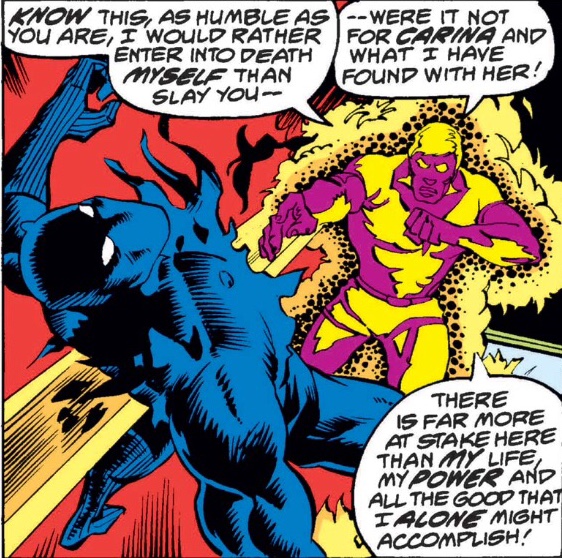
And I’m sparing you the panel with Henry Pym lying on his back, his entire abdomen scooped out.
The point, of course, is that Michael/Korvac/The Enemy is a foe unlike any the Avengers have seen before. He mows through them with a ruthless efficiency not seen since the Spanish Inquisition. Korvac kills 15 heroes in the span of four pages, and then something remarkable happens.

The only kinda sorta super-powered Captain America faces off against Korvac alone, and it takes an entire page for Korvac to defeat him.
Then Wonder-Man, whose primary personality trait up til now has been a crippling fear of death, also gets a full page.

The actions of these two give the surviving powerhouses (Thor, Iron Man, the Vision, and Starhawk) time to regroup and coordinate their attack. Then, just as Korvac about to defeat them all, he looks to his lover, and sees fear and doubt in her eyes. Demonstrating that perhaps his intentions were as benevolent as he claimed, Korvac has enough empathy to see things from her (and the Avengers) perspective, and, using all of his remaining power, brings everyone back to life.

Predictably, this doesn’t please Carina, who unleashes her cosmic power, easily slaying Iron Man, the Vision, and Starhawk. Face to face with Thor, she uses her power to commit suicide.

(I guess we’re supposed to assume that the glow surrounding her as she dies is her bringing Iron Man, the Vision, and Starhawk back to life…)
Conveniently, the only Avenger on their feet happens to be a doctor who can save those Avengers in need of treatment. You’d think he’d start by patching up the massive hole that Korvac drilled through T’Challa’s chest.

Other Comics I Read From August 1978
- Cerebus 5
- Defenders 65
- Incredible Hulk 229
- Justice League of America 160
- Marvel Team-Up 75
- Spidey Super Stories 37
- Twilight Zone 87
- Underdog 21
- Uncanny X-Men 115
August 1983
Dreadstar 6

Our protagonist Vanth Dreadstar has gathered a ragtag group of rebels to aid him in his fight against the Lord High Papal and the twelve Gods of the Instrumentality. This is the issue where we (and his newest recruit, Skeevo) are finally privy to Vanth’s Master Plan. It begins with a previously unseen character addressing a crowd.

Plan M, as the cover dramatically tells us, stands for:

That is some pretty jaded stuff right there. And it gets worse. So much worse:

Remember, Vanth is the guy we’re supposed to be rooting for. This may be the most cynical thing I’ve ever read in my life. Sadly, Vanth hasn’t hit rock bottom just yet. There’s just a little bit deeper he can sink:
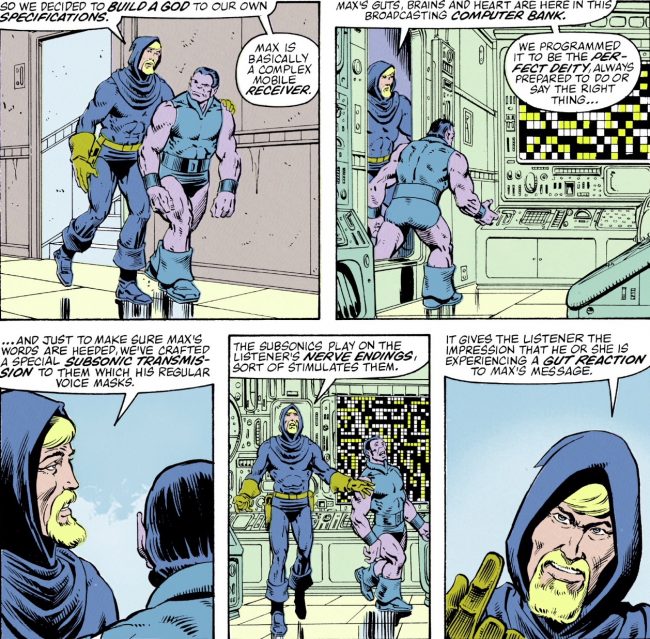
So, our heroes’ secret plan is to defeat a religious oligarchy by replacing it with one that they created out of whole cloth, using a robot messiah that they programmed to remove the free will of the people. Good show, Vanth!
And worst of all — preposterously — while Dreadstar goes on for another 58 issues, this is literally the last we see or hear about Max or Plan M. No shit.
Comics I Read From August 1983
- Alien World 4
- Alpha Flight 4
- Amazing Spider-Man 246, 247
- Avengers 237
- Badger 1
- Captain America 287, 288
- Cerebus 53
- Cloak and Dagger 2
- Defenders 125
- Falcon 2
- Green Lantern / Green Arrow 2
- Hawkeye 3, 4
- Ka-Zar 29
- Kull the Conqueror 3
- Marvel Fanfare 11
- Marvel Team-Up 135
- Moon Knight Special Edition 2
- Peter Parker the Spectacular Spider-Man 84
- Sword of the Atom 3
- Thor 337, 338
- Thriller 1
- Twisted Tales 5
- Uncanny X-Men 175
- Vigilante 1
August 1988
Animal Man 4

Having witnessed the violent death of a man who was threatening to sexually assault her, Ellen Baker channels her energy into saving some motherless kittens.

And Maxine breaks all of our hearts:

Later, after Buddy returns from his super-hero adventure (it’s okay that we don’t remember or care — trust me when I say that Grant Morrison was more concerned about Ellen and the kittens, too) Morrison begins his assault against the grim and gritty Watchmenization of super-hero comics with these four humble panels.

Miracleman 15

And, in the same month that Morrison begins his non-violent assault on hyper-violent super-hero comics using nothing but a kitten and a typewriter, Alan Moore and John Totleben complete their thesis on comic book violence. This is perhaps the most violent issue of a mainstream comic book ever published, and it was clearly conceived to be exactly that. As Alan Moore has said many times over the last 30 years, he sincerely thought he was hammering the final nails into the coffin of super-hero storytelling, not giving it a violent new lease on life.
We begin with our heroes entering London to find their nemesis standing amidst a Bosch painting of filth and horror.

This is followed by a double-page spread that I have to say lives up to the description that precedes it. Look it up if you have to.
And they fight. And countless humans die while they do so. If you ever wondered what in the world Young Zack Snyder was exposed to that made him conceive of the wildly inappropriate ending to his Superman movie, the answer to your question is undoubtedly “Miracleman 15.”
Part of the power set of their enemy (the former Kid Miracleman) is a completely impenetrable force field. This prevents our heroes from stopping (or even hurting) him. But, eventually, the Warpsmith solves the force field problem:

With no other options, Kid Miracleman says the keyword that swaps his body with that of innocent young Johnny Bates. Fully aware of what has happened — and his role in it — Bates is immediately in shock, but Miracleman comforts him.

Alan Moore is a lot of things, but a bad writer isn’t one of them.

Other Comics I Read from August 1988
- Batman: The Cult 4
- Hellblazer 12
- Incredible Hulk 350
- Marvel Fanfare 41
- Punisher 14
- Question 21
- Swamp Thing 79
- V for Vendetta 4
- Wasteland 12
- Whisper 19
August 1993
Enigma 7

The closer we get to the end of Enigma, the more we suspect that we’re heading for an ending that will be — to coin a phrase — enigmatic. Then again, where and how we end becomes less important with the turn of each page, as Peter Milligan’s writing has always been primarily about narrative style, and nowhere moreso than here.

He almost manages to make you not notice that he just slipped a gay sex scene (featuring a super-hero and the book’s protagonist) into a 1993 comic published by DC.
Eventually, they put their clothes on and confront the comic’s super-villain, who happens to be Enigma’s mother, who happens to be dying in a hospital bed.

Again with the lizards. At one point, failing yet again to illustrate a point he was trying to make, Enigma waves his Christ-like hands toward some lizards and says that if he gave one of them human intelligence even they would understand what he was talking about. At the end of the story it is revealed that this entire narrative has been spoken by an intelligent lizard to his less-than-comprehending lizard friends.

And clearly this lizard was a Richard Brautigan fan.
Milk and Cheese Fourth Number One

Evan Dorkin’s Milk and Cheese is kind of a one-note strip, but it’s a really great note. And while the anger and ultra-violence may get old quickly, his detailed art work never does.
One of the highlights of this issue is Milk and Cheese Eating Sugar. (#SentencesINeverThoughtI’dType)

If you’re not amused by an anthropomorphic carton of milk and wedge of cheese shoveling pure cane sugar into their mouths while shouting their desire to “partake in glucose in amounts overwhelming,” then I guess this comic isn’t for you.
But we all know that was just prelude for some serious violence.

Later, in an effort to calm down, Milk and Cheese decide to try pot.

“Cute” Milk and Cheese are somehow even funnier than “angry” Milk and Cheese.
Finally, Milk and Cheese remain unconscious long enough to give us the positively Biblical “Milk and Cheese fall asleep from drinking too much cough syrup for its alcohol content and dream of the terrors and wonders God inflicted on the people of Egypt”

Comics I Read from August 1993
- 1963 5
- Animal Man 64
- Cerebus 173
- Daredevil: The Man Without Fear 1
- Demon 40
- Extremist 1
- Flash 82, 83
- Golden Age 1
- Hellblazer 70
- Incredible Hulk 410
- Jonah Hex: Two-Gun Mojo 3
- Last One 3, 4
- Maxx 4
- Miracleman 24
- Sandman 54
- Sandman Mystery Theater 7
- Shade the Changing Man 40
- Spider-Man 39
- Swamp Thing 136
- Vertigo Visions: The Phantom Stranger
August 1998
Hitman 31

Seeking a windmill to tilt at, Tommy and his friends find themselves on the other side of the world, and almost immediately realize that they’re fighting for the wrong side. The men who hired him aren’t too happy to learn of this change of heart, and Tommy is left for dead in the desert.
Assuming death is inevitable, Tommy confesses his sins to another doomed mercenary.

They live long enough to face certain death at the hands of their enemies.

Then, just as it looks like Tommy is done for:

As Tommy’s savior bleed out, Tommy has one more confession to make:


That last little bit is Garth Ennis at his very best. Both the notion that a dying man could be more concerned with the mental well being of a man he met days ago, and Tommy’s ability to process and accept that kindness.
Invisibles 19

Mr. Quimper presents a compelling argument against individuality and subjectivity.

Below, the use of blank/black panels between each of Quimper’s statements makes them that much more horrifying:

Meanwhile, Jack plays chess with the Accuser, who reveals the true meaning of life.

Within the world of the Invisibles (and, according to Grant Morrison, in our world as well) this is the true Nature of Reality. Not only are we all in “the Matrix,” but we have entered it of our own free will, several times, each time choosing to play a different character. And the rules of the game are such that in order to play you must so identify yourself with the part you are playing that you are unable to distinguish between the character and yourself. To put it another way, the “individual” you think you are is no more real than the Bishop on a chess board.
Remember the British pop star Howard Jones? Back in 1984 he had a hit called “Hide and Seek.” The song includes the following stanza:
She completely forgot where she’d hidden herself
And she spent the rest of her time
Trying to find the parts
On one level, this sounds like good news — death is an illusion, we are eternal beings, all of the unfair horror we encounter on a daily basis isn’t “real,” etc. But, if this sounds good to you, please go back and reread Mr. Quimper’s speech above, and realize that you are now kind of agreeing with him. Would you purchase immortality if the price was your individuality?
Grant Morrison allowed his struggle with this notion of reality to inform — and change — the story he was telling in the Invisibles, to the point where — by the end of the story — he was no longer willing to differentiate between the “good guys” and “bad guys.”

So much genuine horror in those panels. I love the notion that these assassins were trained to interpret everything that happens to them as a manifestation of the divine. And that it was the simple act of holding hands that allowed them to resist the enemy.
JLA 23

Grant Morrison has always maintained that if Superman didn’t exist, someone would simply create him. Here that idea finds its first purely fictional representation.
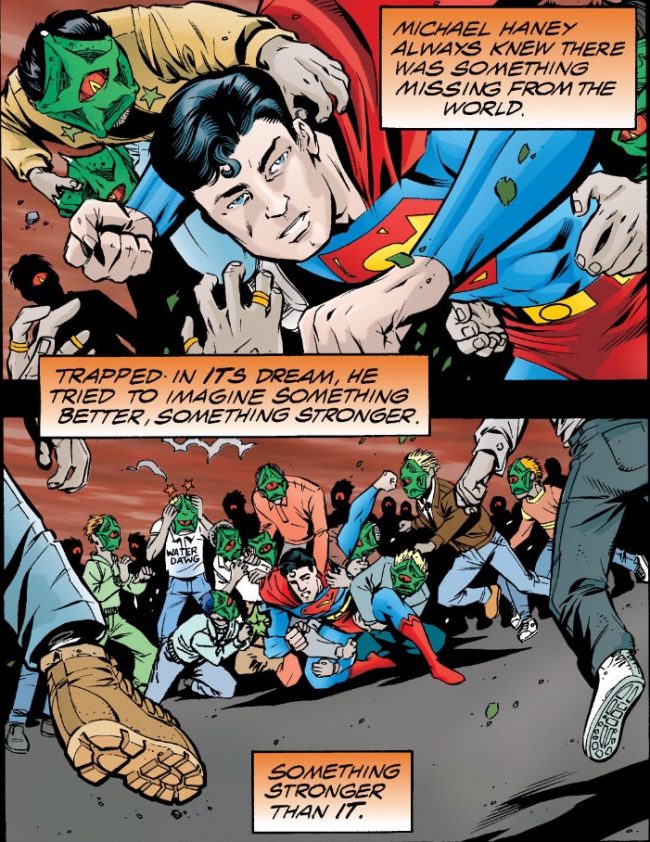
Trapped in a world without Superman (or super-heroes at all) Michael’s belief saves Superman himself — which, of course, allows Superman to save him. Morrison is a huge fan of the Silver Age notion of the reader being called upon to save the super-hero.

While Superman gets the headlines, Batman lurks behind the scenes, working to solve problems on a larger and less-personal scale.

Batman never has time to be wrong, which is why it’s so fortunate that Batman is always right.

And, just as you were forgetting that they were sent into a dreamworld by Daniel, Lord of Dreams…

Preacher 42

Separated from Tulip and Cassidy, Jesse finds himself in Salvation, Texas, where he quickly finds himself sheriff.

And just as quickly finds himself face-to-face with the corrupt businessman who seemingly runs the town.


Ol’ Odin’s lawyer immediately comes to the scene, making it clear that this sort of violence is outrageous and illegal. But Odin has other ideas.

Later, Jesse catches up with his old friend Lorie. He asks her about Jodie, the older woman who owns the local bar.

Unsatisfied, Jesse seeks out Jodie.


And we have another great example of how Garth Ennis could make 30 days seems like a very long time.
Other Comics I Read from August 1998
- 300 4
- Avengers 9
- Captain America 10
- Captain America: Sentinel of Liberty 2
- Flash 142
- Guns of the Dragon 1
- Hellblazer 130
- JLA: Year One 10
- Jonny Double 2
- Madman/Jam 2
- Minx 1
- New Gods Secret Files 1
- Starman 47
- Stormwatch 10
- Superman Adventures 24
- Superman for All Seasons 2
- Transmetropolitan 14
- WildCATS/Aliens 1
August 2003
Avengers 70

The conclusion of Geoff John’s epic Avengers story begins with the Black Panther confronting the Red Skull.

T’Challa removing his clawed gauntlets — presumably so that the Red Skull could see and feel that he was being beaten by Black fists — is chilling.
Meanwhile, Steve Rogers is down — breathing the deadly toxic red mist that Red Skull has unleashed on America — and Tony Stark does the truly heroic thing.

Black Panther takes a moment to deliver a lecture on diversity before making good on his promise.
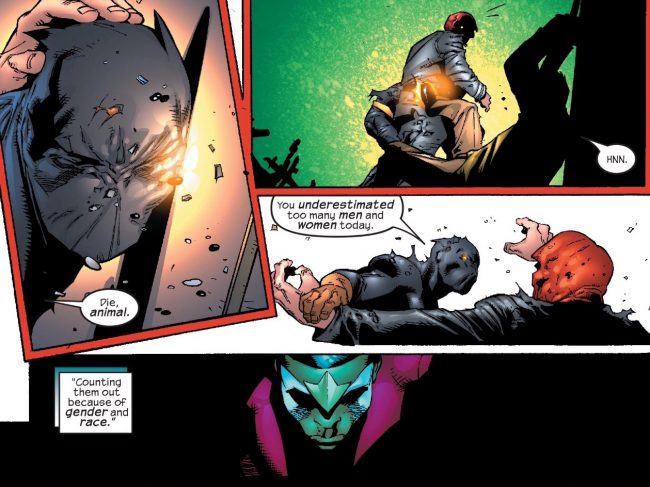

Turns out the antidote to Red Skull’s poison is in his blood, which Black Panther is all too happy to remove.
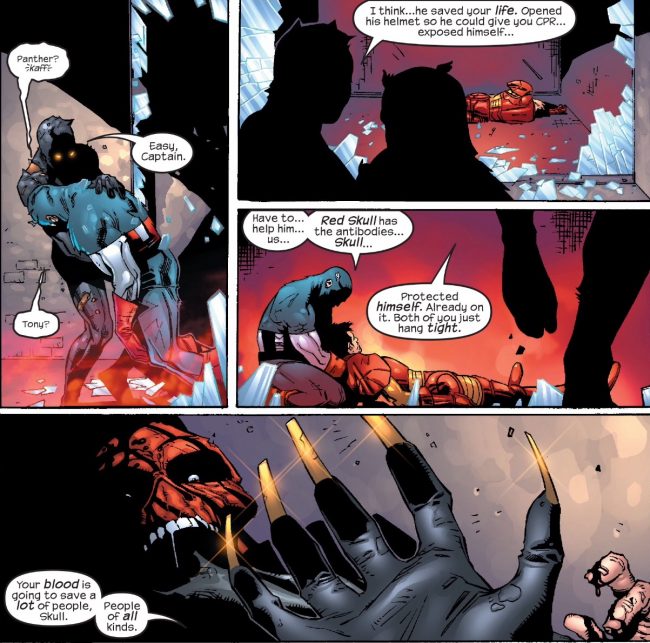
Filth 13

The Filth was Grant Morrison’s anti-Invisibles — turning the ultra-cool, ultra-violent world of hip underground assassins defending the world from conformity on its head, showing us a very different world, where the heroes protect the boring and the mundane (i.e., us) from the unique and the strange.
At the end, our hero — a pathetically normal man who was tricked into thinking he was a super-spy — confronts who he thinks is the Big Bad, only to find a frightened disfigured adolescent girl.
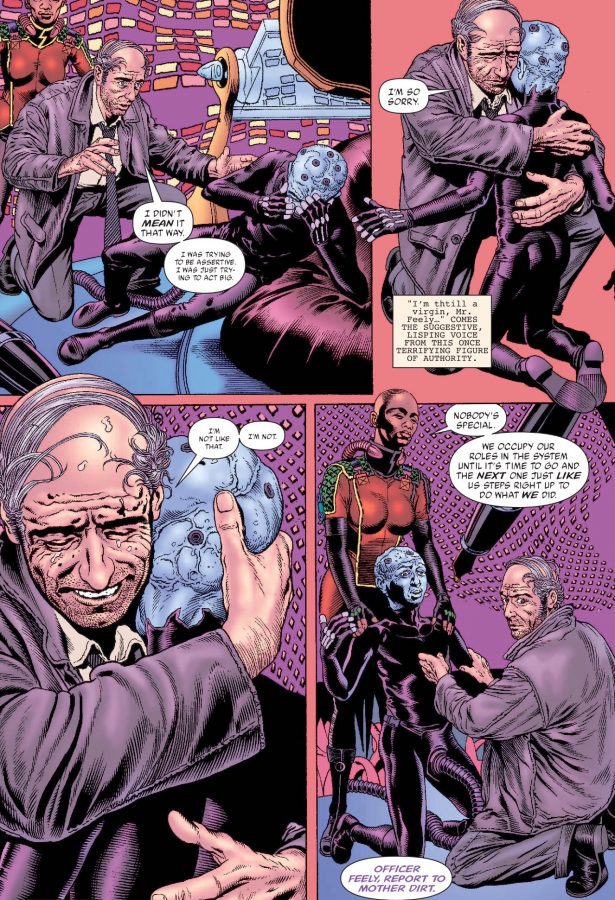
And Mr. Quimper’s argument about the disease of individuality from five years ago is repeated, but this time coming from the “good guys.”
Ned Feely visits Mother Dirt, who tries to explain why what happened to him was necessary — and better for the whole of the organism.

And Mother Dirt delivers what may be my favorite line in the history of comics:

Later, we join Ned back in the “real world” as he discusses iLife with a neighbor.

Greg delivers iLife to a comatose man while also delivering The Filth’s primary metaphor:

And, we end as we began, with Ned and his cat. Ultimately, the scale this story was taking place on — whether the characters were microscopic beings working together to help heal our bodies, or we are all working together to help heal our planet — is unimportant. There is only one thing we need to understand, and only one thing truly matters.

We have love.
New X-Men 145

Meanwhile, in a much more mainstream comic book, Grant Morrison finally relents, putting Wolverine front and center in a New X-Men storyline.
Wolverine, Cyclops, and Fantomex end their adventure on Weapon Plus’ The World by planting enough explosives to completely obliterate it. Before they depart, Fantomex delivers the bait that got Wolverine to participate in the first place.

As the name Weapon Plus makes clear, Morrison re-frames the X in Wolverine’s Weapon X designation from the letter X to the number 10. This of course, means that there were nine victims of the Weapon Plus program before Logan, and who knows how many after. In fact, we learn that Fantomex is Weapon XIII.
But there are more shocking revelations to come…

Steve Rogers: Weapon I. And remember Nuke from Daredevil: Born Again? Weapon IX? Also, the reason why they wiped Logan’s memory in the first place.

Shortly after reading the lost Weapon X files — and presumably learning secrets about his past that had long ago been erased — Logan encounters Ultimaton, aka Weapon XV, who (having — as far as he can tell — just been born) has a few questions.

The World explodes, with Ultimaton and Wolverine in it. Who will survive? Tune in next month.
Other Comics I Read from August 2003
- Alias 25
- Amazing Spider-Man 56, 57
- Arkham Asylum: Living Hell 4
- Batman 618
- Batman: Death and the Maidens 1
- Born 3
- Captain America 16
- Catwoman 22
- Daredevil 50
- Detective Comics 785
- Empire 2
- Epicurus the Sage
- Fantastic Four 502, 503
- Flash 201
- Goon 2
- Gotham Central 10
- Hawkman 18
- Hellblazer 187
- Human Target 1
- Incredible Hulk 59
- JSA 51
- JSA All Stars 4
- Losers 3
- Lucifer 41
- Mystique 5
- Planetary 16
- Possessed 2
- Powers 34
- Punisher 30
- Red 2
- Reload 3
- Runaways 5
- Sleeper 8
- Smax 1
- Startling Stories: The Thing: Night Falls on Yancy Street 4
- Superman: Birthright 2
- Teen Titans 2
- Thor: Vikings 2
- Tom Strong 21
- Trouble 2
- Ultimate Spider-Man 44, 45
- Ultimate X-Men 36
- Wolverine 4
- Wonder Woman 195
- X-Statix 12
- Y: The Last Man 14
August 2008
All-Star Superman 12

Grant Morrison and Frank Quitely begin the final chapter of their masterpiece with Superman powerless and dying, and Lex Luthor — possessing the full power of Superman — teaming up with Solaris, the Tyrant Sun.
With Superman out of the picture, Lex is confronted by the staff of the Daily Planet.

But just as Lex is going to destroy them all, Superman arrives to save the day!

Then, something unexpected happens. Turns out that it’s impossible to have the full powers of Superman and remain an asshole. The very act of using super-senses makes you empathetic. How could it not?

Some strange stuff going on in this next page.

I love the idea that Lex could have saved the world whenever he wanted, with or without Superman. I’m not sure, however, how I feel about Superman announcing that brain beats brawn and then immediately punching Luthor in the face.
Regardless, this is the perfect distillation of Lex Luthor. He’s truly brilliant, genuinely frightening, deliciously human, and even kind of sympathetic — all at the same time. After reading this, I began work on a song written from Luthor’s perspective, that ended up being titled Suprema Lex. It remains one of my favorite Ookla the Mok tracks. Please check it out. I’ll wait here.
Of course, defeating Luthor doesn’t change the fact that Superman is dying and the sun is broken.

And one page is more than Grant Morrison and Frank Quitely need to demonstrate the powerful love of Superman and Lois Lane.
We end with a strange scene with Dr. Quintum and his assistant Agatha.

When Quintum says “Now that we now how it’s done” he’s referring to the fact that Superman gave Quintum access to his genetic code. In essence, Quintum can use Superman’s DNA to create a world of Supermen. And we’ve already established that having access to that power creates empathy, so we know that the world is in good hands. Even without Superman, the world will be saved.
But what of Lex Luthor? Go back and reread that last page of dialog.
I submit that Leo Quintum is Lex Luthor.
Before we get into evidence, we can begin with two things about Grant Morrison. One: the understanding that this is exactly the sort of thing Morrison would put into a story and *not* talk about or make abundantly clear. When some fans accuse Morrison of “not making any sense” what they really mean is that he’s asking them to meet him half-way, and do a little interpretive work when reading his stories. Two: yes, in order for this be true, we need to be talking about time travel, and possibly multiple time-lines, but a complex view of reality (specifically in terms of time travel) is one of the primary tropes of Grant Morrison’s fiction.
So , that being said, let’s start with physical appearance. Look at Quintum. That familiar jacket. The face shape. And bear in mind that Quitely is famous for his use of varied body types and facial shapes. Now, note the absurd similarity between Agatha’s hair and Lex’s niece’s helmet. And how delicious that Lex’s disguise is a wig and a pair of glasses!
Next, the name. X to O is Lex to Leo. And Quintum implies five. The issue of ASSM where Clark interviews Lex in prison contains an unreasonable amount of references to the number five.
Check out Luthor’s prisoner number on the cover:

2 + 2 + 1 = 5. And, of course, it’s issue five of the series.
Some dialogue clues: The first time we meet Quintum, he says to Superman, “I’m trying to escape from a doomed world too… It’s called the past.” And when Superman gives Quintum his DNA, Quintum questions Superman’s faith in him by delivering the insanely provocative line, “I could be the devil himself.” When I first read that, I assumed it was there to warn us of some future treachery. But nothing ever comes of it. I would argue that it’s a clue left for us to find.
Lastly, throughout the series, Superman knows he is dying, and sets himself several tasks he hopes to accomplish before he dies. We never see the list, but we see the results. And doesn’t it just makes sense — thematically, and based on everything we know about Superman’s character — that a major bullet point on his bucket list would be reforming Lex Luthor?
Batman 680

Not a whole lot to discuss here. Just one amazing moment — and probably my favorite panel in all of Morrison’s Batman work.
One of the more controversial aspects of Batman: RIP was Morrison’s inclusion of Bat-Mite, a fifth-dimensional imp who is obsessed with Batman. After enjoying lots of exposure during the anything goes (and very kid-friendly) 60s DC comics, Bat-Mite was one of many embarrassing characters removed from DCU continuity after 1985’s Crisis on Infinite Earths. Morrison brought him back during Batman: RIP, making it unclear to the reader (and to Batman himself) if he was “real” or not.

And Bat-Mite gives the greatest possible answer:

Other Comics I Read from August 2008
- 100 Bullets 94
- Action Comics 868
- Air 1
- Amazing Spider-Man 658, 659
- Army @ Love 1
- Astonishing X-Men 26
- Avengers: The Initiative 16
- Black Panther 40
- Booster Gold 11
- Brave and the Bold 16
- Captain America 41
- Criminal 6
- Daredevil 110
- DC Universe: Last Will and Testament 1
- DMZ 34
- Final Crisis: Legion of Three Worlds 1
- Final Crisis: Revelations 1
- Final Crisis: Rogue’s Revenge 2
- Final Crisis: Superman Beyond 1
- Ghost Rider 26
- Goon 27
- Green Lantern 34
- Green Lantern Corps 27
- Halo: Uprising 3
- Haunt of Horror: Lovecraft 3
- Hellblazer 247
- Hellblazer Special: Chas 2
- I Kill Giants 2
- Immortal Iron Fist: The Origin of Danny Rand
- Incredible Hercules 120
- Infinity, Inc. 12
- Invincible Iron Man 4
- JSA 18
- Kick-Ass 4
- Marvel 1985 4
- Mighty Avengers 17
- New Avengers 44
- Nightwing 147
- Northlanders 9
- Punisher 60
- Punisher War Journal 22
- Scalped 20
- Secret Invasion 5
- Secret Invasion: Thor 1
- She-Hulk 32
- Skaar: Son of Hulk 3
- Special Forces 3
- Thunderbolts 123
- Tiny Titans 7
- Transhuman 3
- Ultimate Origins 3
- Ultimate Spider-Man 125
- Uncanny X-Men 501
- Walking Dead 51
- Wolverine 68
- X-Factor 34, Layla Miller Special
August 2013
Batman and Robin 23

This issue of Tomasi and Gleason’s Batman and Robin finds Bruce using a VR machine to relive the moments leading up to Damian’s death over and over again — searching (in vain) for how he might have prevented the tragedy.

And while Dick says he knows when Bruce can’t be talked off the ledge, he clearly understands that sometimes getting up on the ledge with them is the only way to get close enough to talk someone down.

Then, we see the events leading up to Damian’s death from Alfred’s perspective.

Or is there?

And we learn — to his horror and shame — that Alfred can accomplish what even Batman cannot.

Batman/Superman 3

The first three issues of Batman/Superman have ostensibly been telling the story of the first time Batman and Superman met. But, in this back up story, we learn that they met as children long before either of them donned a cape and tights. Alfred’s Town Car breaks down just outside the Kent’s Kansas farmhouse.
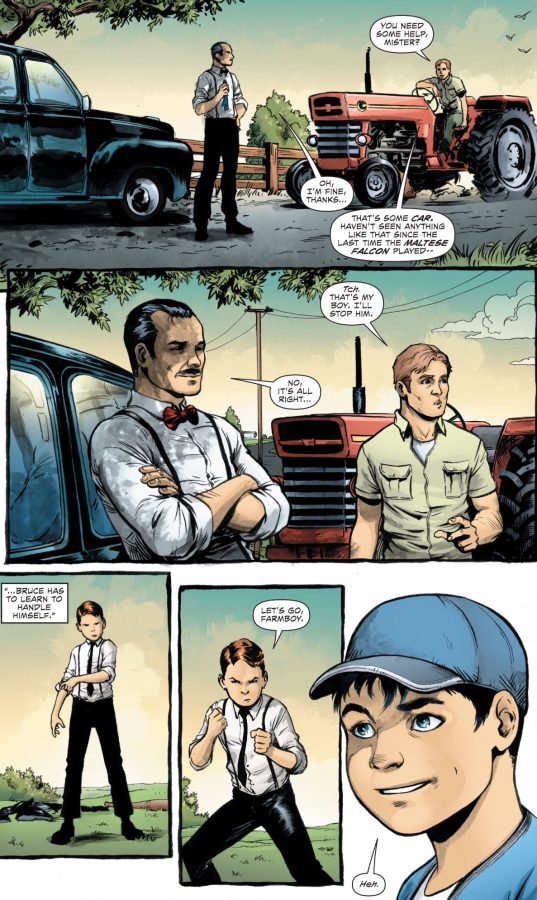
Bruce’s confidence amuses Clark, but it turns out that Clark is the overconfident one.

And young Clark’s response is perfectly in character.

Later, Alfred comes clean.
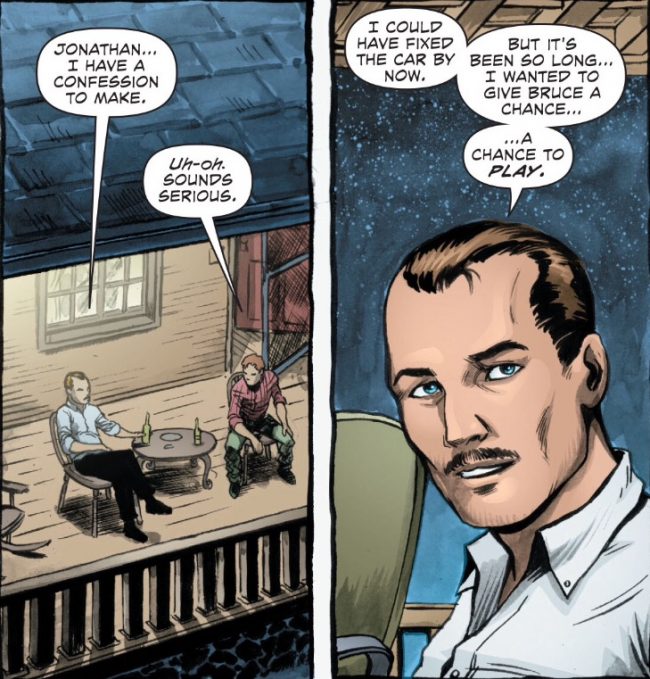
Bruce shows some budding detective skills, and Clark makes it clear why Bruce has always been his best friend.

Other Comics I Read from August 2013
- 100 Bullets: Brother Lono 3
- Activity 14
- All-New X-Men 15
- American Vampire Anthology 1
- Animal Man 23
- Aquaman 23
- Astro City 3
- Avengers 17, 18
- Avengers Assemble 18
- Batman 23
- Blackacre 9
- Captain Marvel 15
- Daredevil 30
- East of West 5
- Fatale 16
- Great Pacific 9
- Green Arrow 23
- Indestructible Hulk 12
- Infinity 1
- Iron Man 14
- Itty Bitty Hellboy 1
- Justice League 23
- Justice League of America 7
- Kick-Ass 3 2
- Lazarus 3
- Legend of Luther Strode 6
- Manhattan Projects 13
- New Avengers 9
- Revival 13
- Saga 13
- Satellite Sam 2
- Secret 3
- Sheltered 2
- Sidekick 1
- Superior Foes of Spider-Man 2
- Superior Spider-Man 15, 16
- Thanos Rising 5
- Thief of Thieves 16
- Thor: God of Thunder 11, 12
- Trillium 1
- Uncanny X-Men 10, 11
- Walking Dead 113
- Wolverine and the X-Men 34, 35
- Wonder Woman 23
- X-Factor 260, 261
- Young Avengers 9
Dear Spoilerite,
At Major Spoilers, we strive to create original content that you find interesting and entertaining. Producing, writing, recording, editing, and researching requires significant resources. We pay writers, podcast hosts, and other staff members who work tirelessly to provide you with insights into the comic book, gaming, and pop culture industries. Help us keep MajorSpoilers.com strong. Become a Patron (and our superhero) today.


